
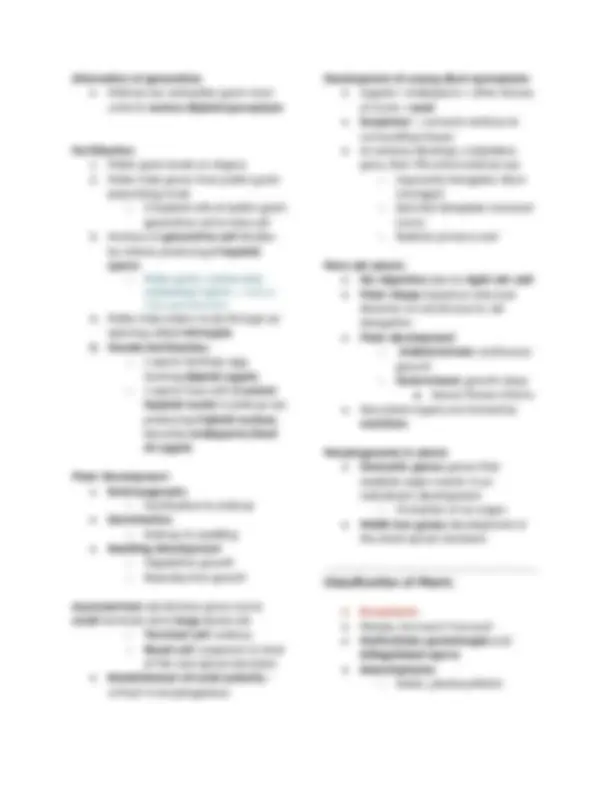
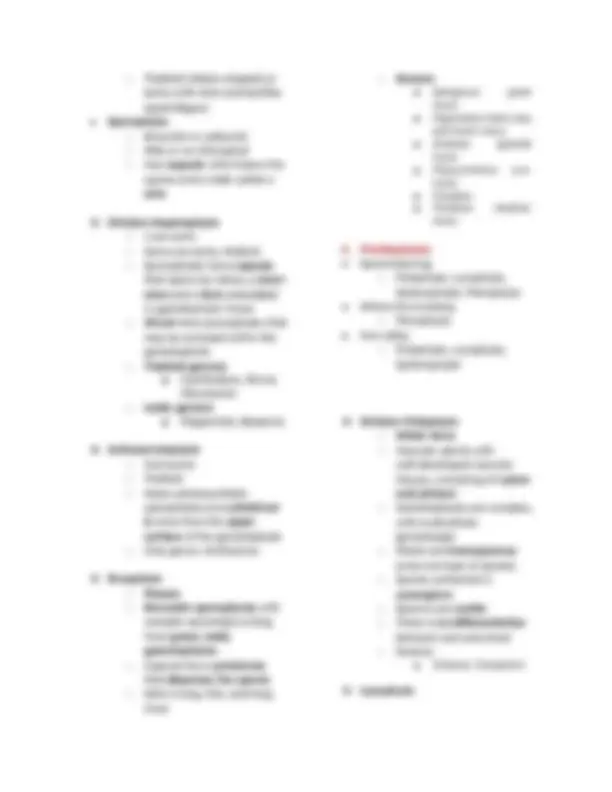
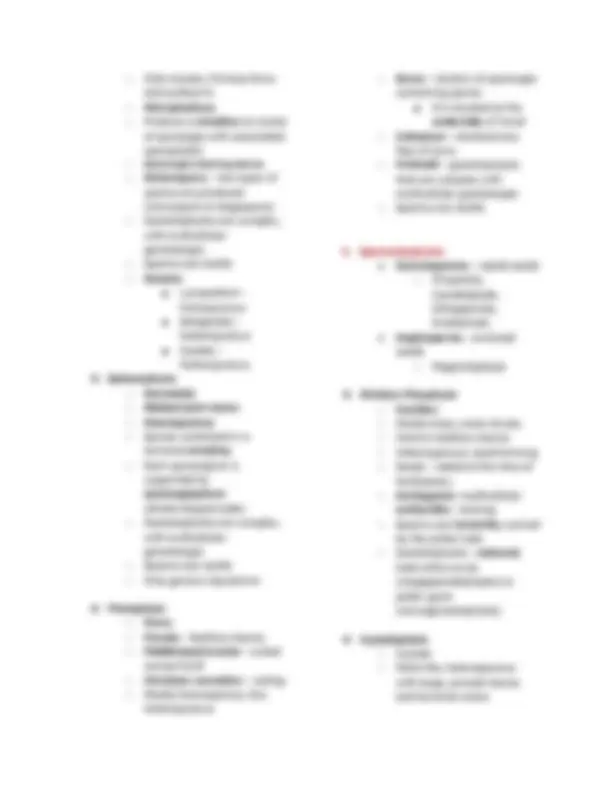
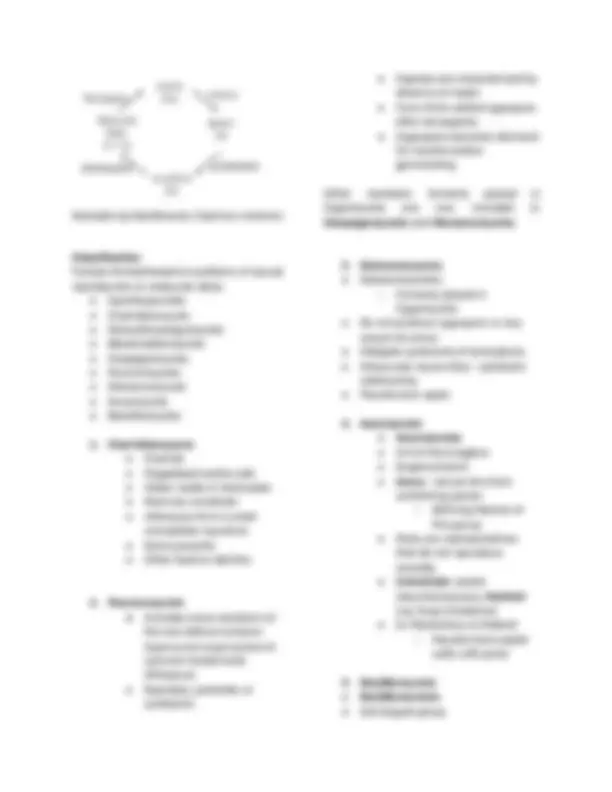
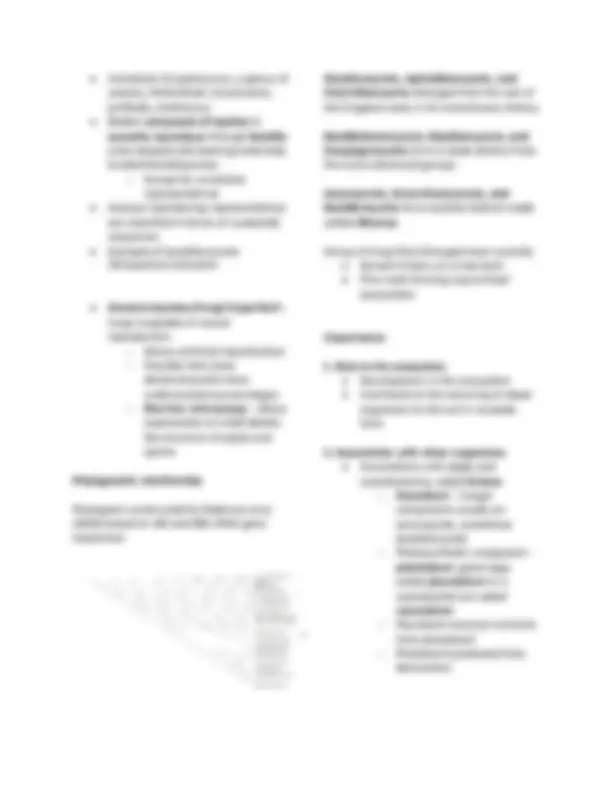
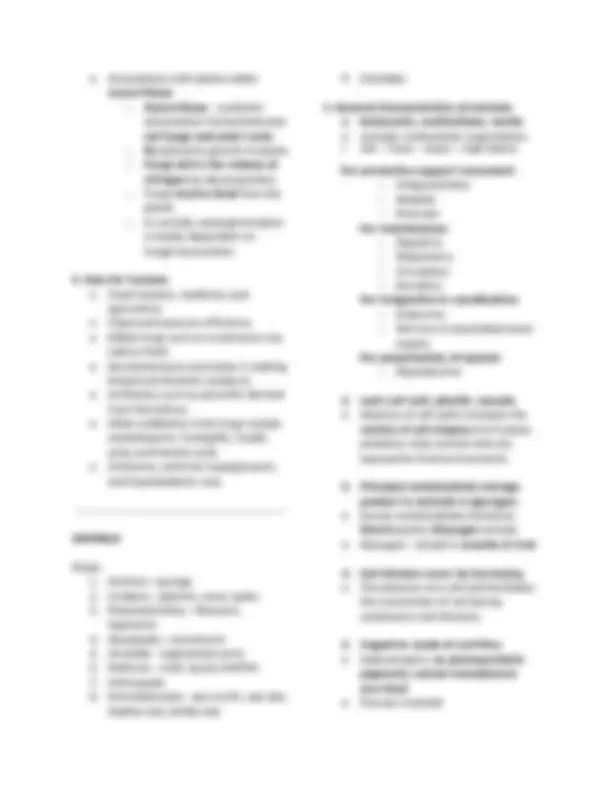
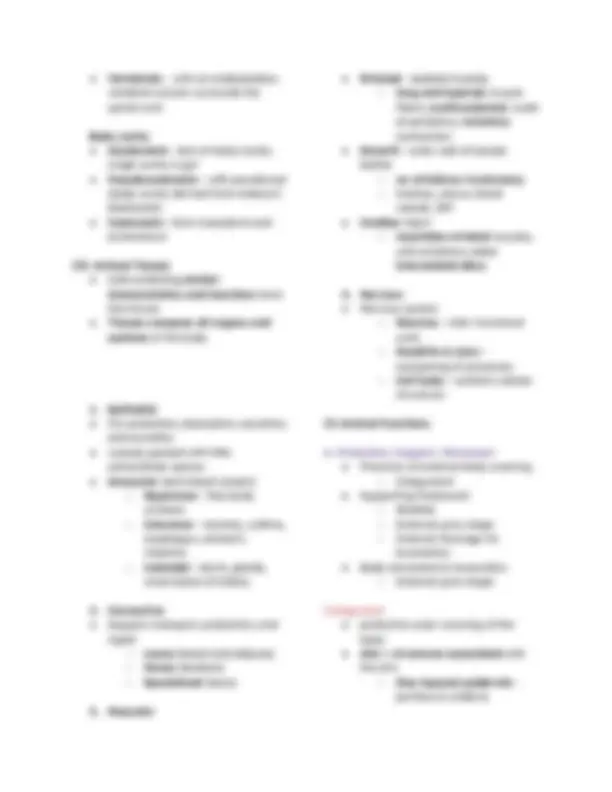
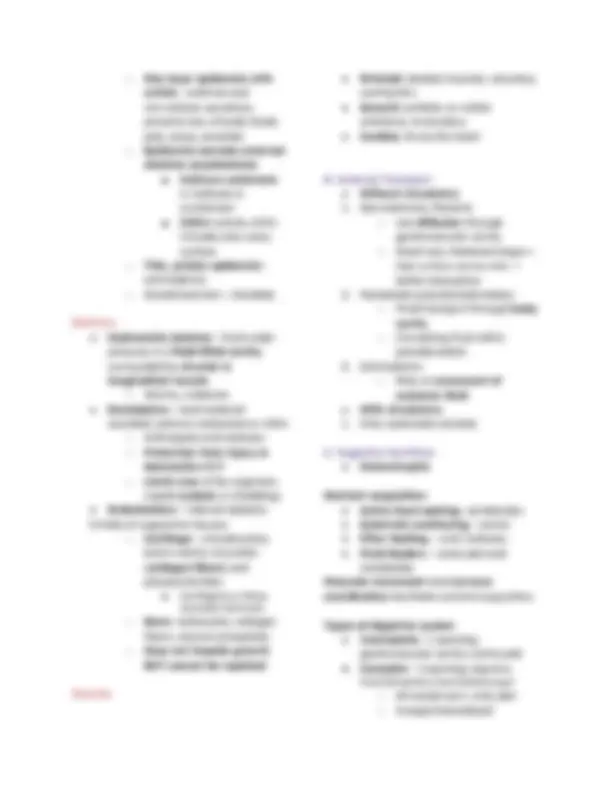
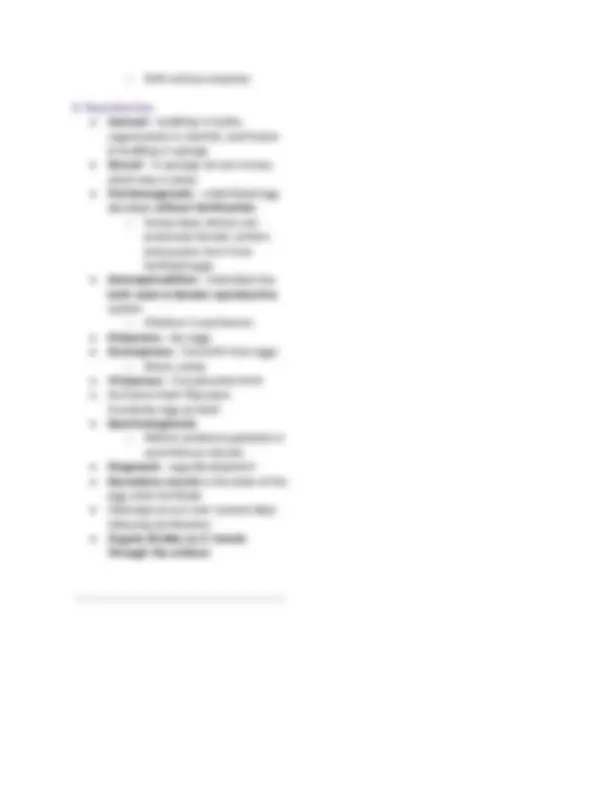


Study with the several resources on Docsity

Earn points by helping other students or get them with a premium plan


Prepare for your exams
Study with the several resources on Docsity

Earn points to download
Earn points by helping other students or get them with a premium plan
Community
Ask the community for help and clear up your study doubts
Discover the best universities in your country according to Docsity users
Free resources
Download our free guides on studying techniques, anxiety management strategies, and thesis advice from Docsity tutors
BIOLOGY PLANTS FUNGI ANIMALS KINGDOMS DIVISIONS CHARACTERISTICS
Typology: Study notes
1 / 15

This page cannot be seen from the preview
Don't miss anything!










1. Roots ● Function: ○ anchorage ○ water & dissolved nutrient absorption ● Root systems: ○ Taproot & fibrous: arise from radicle ○ Adventitious: arise from anything other than radicle Root cap ● 3 regions: ○ Region of cell division: youngest cells ○ Region of elongation ○ Region of di�erentiation/maturation: root hairs ● Thimble shaped mass of parenchyma cells at the tip of root; protects root from injury ● Dictyosomes or golgi bodies release lubricant cells: mucigel (lasting for 1 week) ● Important in perception of gravity (geotropism or gravitropism) ● Amyloplasts or statoliths accumulate at the bottom of cells ● Solute concentration in cytoplasm of root cell > water in soil ● Water di�uses by osmosis. It crosses cortex of root to enter xylem via: ○ Symplastic route: water moves from cell to cell ; water enters cytoplasm through plasmodesmata (cytoplasmic connection) ○ Apoplastic route: water moves by capillary action ; water enters endodermis through cortex cell wall; (90% of water moves using this route) ■ Casparian strip: blocks apoplastic ● Metamorphosed root ○ Pneumatophore - mangroves ○ Photosynthetic roots ○ Buttress roots ○ Symbiotic roots: legumes form root nodule ■ Mycorrhizae “fungus roots” protects plant against pathogen & increase surface area for nutrient absorption ■ plant provide food in form of sugar and amino acid 2. Metamorphosed stem ● Tendril ● Bulb - onion bulb ● Tuber ● Rhizome - produce new indiv at nodes below ground ● Stolon - produce new indiv at nodes aboveground ● Cactus stem - store water ● Thorns - provide protection
3. Leaf Leaf of monocot plant ● Often not di�erentiated into palisade and spongy layers ● Cells surrounding the vascular tissue (bundle sheath) are distinctive ; often the site for carbon fixation (C4 photosynthesis) ● Bulliform cells : turgid when there’s water (leaf is exposed); collapse when lacking water (leaves curl inwards) Leaves of an aquatic plant: ● stomata in the upper epidermis only ● large intercellular spaces in the spongy mesophyll layer provide buoyancy Metamorphosed leaf: ● Onion leaves store food ● Aloe vera leaves store water ● Leaf tendrils aid in climbing ● Bracts attract pollinator ● Dark hood trick prey ● Flowerpot plant leaves collect soil
Types of Reproduction: ● Asexual - no gametes involved; o�spring are clone of parents; no genetic variation in o�spring ○ Tuber - potato has buds (eyes) ○ Runner ○ Plantlet ○ Rhizome ● Sexual - involve gametes (sperm & egg); o�spring genetically di�erent from parents In Angiosperms: Male Gametophyte production ● Stamen = filament + anther ● Inside anther , microsporocyte (microspore mother cell) undergo meiosis to produce microspores ○ Meiosis form 4 haploid daughter cells called pollen tetrads ○ Anther = male sporangium ○ Each pollen tetrad = microspore ■ Microspores because of their small size ○ As anther matures, the 4 microspores separate ○ Haploid nucleus of each microspore undergo mitosis ○ Resulting to 2 haploid nuclei , encased in thick resistant wall forming a pollen grain ■ Pollen grain: immature male gametophyte Female gametophyte production ● Pistil = stigma + style + ovary ● Ovary contains ovules. ● Inside ovule, a megasporocyte undergoes meiosis producing megaspores. ● Meiosis form 4 haploid megaspores ● Only 1 haploid spore matures; undergoes 2 rounds of mitosis ; forming embryo sac which has 8 haploid nuclei ○ Embryo sac : female gametophyte ○ Embryo sac: 3 antipodal cells, 2 polar nuclei, 2 egg synergids
○ Thalloid (ribbon-shaped) or leafy (with stem and leaflike appendages) ● Sporophyte : ○ Brownish or yellowish ○ little or no chlorophyll ○ Has capsule which bears the spores and a stalk called a seta ★ Division Hepatophyta ○ Liverworts ○ Some are leafy, thalloid ○ Sporophytes have capsule that opens by valves, a short stem and a foot embedded in gametophytic tissue ○ Riccia have sporophytes that may be enclosed within the gametophyte ○ Thalloid genera: ■ Cyathodium, Riccia, Marchantia ○ Leafy genera: ■ Plagiochila, Bazzania ★ Anthocerotophyta ○ Hornworts ○ Thalloid ○ Green photosynthetic sporophytes are cylindrical & arise from the upper surface of the gametophyte ○ Only genus:Anthoceros ★ Bryophyta ○ Mosses ○ Brownish sporophytes with complex sporangia arising from green, leafy gametophytes ○ Capsule has a peristome that disperses the spores ○ Seta is long, thin, and long lived ○ Genera : ■ Sphagnum (peat moss) ■ Pogonatum (hairy cap, split-tooth moss) ■ Andreae (granite moss) ■ Physcomitrium (urn moss) ■ Fissidens ■ Thuidium (feather moss)
2. Pteridophytes ● Spore-bearing: ○ Psilophyta, Lycophyta, Sphenophyta, Pterophyta ● Where ferns belong ○ Pterophyta ● Fern allies ○ Psilophyta, Lycophyta, Sphenophyta ★ Division Psilophyta ○ Whisk ferns ○ Vascular plants with well-developed vascular tissues, consisting of xylem and phloem ○ Gametophytes are complex, with multicellular gametangia ○ Plants are homosporous (only one type of spores) ○ Spores contained in synangium ○ Sperms are motile ○ There is no di�erentiation between root and shoot ○ Genera: ■ Psilotum, Tmesipteris ★ Lycophyta
○ Club mosses, Chinese ferns and quillworts. ○ Microphyllous ○ Produce a strobilus (a cluster of sporangia with associated sporophylls) ○ Sporangia-bearing leaves ○ Heterospory - two types of spores are produced (microspore & megaspore) ○ Gametophytes are complex, with multicellular gametangia. ○ Sperms are motile ○ Genera : ■ Lycopodium - homosporous ■ Selaginella - heterosporous ■ Isoetes - heterosporous ★ Sphenophyta ○ Horsetails ○ Ribbed joint stems ○ Homosporous ○ Spores contained in a terminal strobilus ○ Each sporangium is supported by sporangiophore (shield-shaped stalk) ○ Gametophytes are complex, with multicellular gametangia ○ Sperms are motile ○ Only genera:Equisetum ★ Pterophyta ○ Ferns ○ Fronds - feathery leaves ○ Fiddlehead/crozier - coiled young frond ○ Circinate vernation - coiling ○ Mostly homosporous, few heterosporous ○ Sorus - clusters of sporangia containing spores ■ It is located at the underside of frond ○ Indusium - membranous flap of sorus ○ Prothalli - gametophytes that are complex with multicellular gametangia ○ Sperms are motile.
3. Spermatophytes ● Gymnosperms - naked seeds ○ Pinophyta, Cycadophyta, Ginkgophyta, Gnetophyta ● Angiosperms - enclosed seeds ○ Magnoliophyta ★ Division Pinophyta ○ Conifers ○ Mostly trees, some shrubs ○ Hard or leathery leaves ○ Heterosporous; seed-forming ○ Seeds - naked at the time of fertilization ○ Archegonia - multicellular antheridia - lacking ○ Sperms are immotile ; carried by the pollen tube ○ Gametophytes - reduced , held within ovule (megagametophytes) or pollen grain (microgametophytes) ★ Cycadophyta ○ Cycads ○ Palm-like, heterosporous with large, pinnate leaves and terminal cones
● Immotile ● Produce spores ● Have cell walls ● Not plants because: ○ Body organization di�ers from plants ○ Biochemical pathways are completely di�erent ● More closely related to animals than to plants General Characteristics of Fungi
1. Body plan ● unicellular (yeast), filamentous (molds), thalloid (mushrooms) ● In filamentous & thalloid: ○ Hyphae - individual filaments ○ Mycelium - several branches forming a network ● Zygomycetes ○ Hyphae have no cross walls or septa ○ multinucleate cells ○ Chitosan - cell wall ● Ascomycetes & basidiomycetes ○ Hyphae have septa ○ Chitin - cell wall ● Fungi have chitinous cell wall unlike plants which have cellulosic cell wall. 2. Nutrition ● Heterotrophic , unlike plants ○ Biotrophs - parasites obtaining nutrients from living hosts without killing them ○ Necrotrophs - parasites obtaining nutrients from living hosts, eventually killing them ○ Saprotrophs - decomposers obtaining nutrients from dead organisms ● Secrete enzymes that digest macromolecules of their nutrient source. ● Upon breakdown of macromolecules, fungi can absorb them. 3. Life cycle ● Haplontic ○ Zygote - only diploid stage ● Zygotic meiosis ○ Zygote undergoes meiosis resulting in haploid spores that develop into hyphae. ● No male or female ● Plasmogamy - fusion of protoplasts ○ resulting in heterokaryotic cell with 2 unfused haploid nuclei from either individual ● Zygomycetes ○ heterokaryotic cell does not divide prior to karyogamy (fusion of two nuclei) that results to the diploid zygote ● Ascomycetes & basidiomycetes ○ heterokaryotic cell divides without the haploid nuclei fusing ○ produces the fruiting body ( ascocarp in ascomycetes; basidiocarp in basidiomycetes) ○ Karyogamy leads to the formation of the zygote
Example ng basidiocarp:Coprinus comatus Classification 9 phyla formed based on patterns of sexual reproduction & molecular data: ● Opisthosporidia ● Chytridiomycota ● Neocallimastigomycota ● Blastocladiomycota ● Zoopagomycota ● Mucoromycota ● Glomeromycota ● Ascomycota ● Basidiomycota
1. Chytridiomycota ● Chytrids ● Flagellated motile cells ● Water molds in freshwater ● Most are unicellular ● Allomyces form a small nonseptate mycelium ● Some parasitic ● Other feed on detritus 2. Mucoromycota
the now-defunct phylum Zygomycota (zygomycetes) & common bread mold (Rhizopus) ● Saprobes, parasites or symbionts ● Hyphae are characterized by absence of septa ● Form thick-walled zygospore after karyogamy ● Zygospore becomes dormant for months before germinating Other members formerly placed in Zygomycota are now included in Zoopagomycota and Glomeromycota.
3. Glomeromycota ● Glomeromycetes ○ Formerly placed in Zygomycota ● Do not produce zygospore or any sexual structure ● Obligate symbionts of land plants. ● Arbuscular mycorrhiza - symbiotic relationship ● Mycelia lack septa 4. Ascomycota ● Ascomycetes ● 2/3 of the kingdom ● largest phylum ● Ascus - sexual structure containing spores ○ defining feature of this group ● there are representatives that do not reproduce sexually. ● Unicellular yeasts (Saccharomyces), thalloid cup fungi (Cookeina) ● In filamentous & thalloid ○ Mycelia have septal walls with pores 5. Basidiomycota ● Basidiomycetes ● 2nd largest group
● Associations with plants called mycorrhizae ○ Mycorrhizae - symbiotic associations formed between soil fungi and plant roots ○ B eneficial to growth of plants ○ Fungi aid in the release of nitrogen by decomposition ○ Fungi receive food from the plants ○ In orchids, seed germination is totally dependent on fungal association.
3. Uses for humans ● Food industry, medicine, and agriculture. ● Improved resource e�ciency ● Edible fungi such as mushrooms are sold as food. ● Saccharomyces cerevisiae in making bread and alcoholic products ● Antibiotics such as penicillin derived from Penicillium. ● Other antibiotics from fungi include cephalosporin, fumagillin, fusidic acid, and helvolic acid. ● Antitumor, antiviral, hypoglycemic, and hypolipidemic uses ANIMALS Phyla: 1. Porifera - sponge 2. Cnidaria - jellyfish, coral, hydra 3. Platyhelminthes - flatworm, tapeworm 4. Nematoda - roundworm 5. Annelida - segmented worm 6. Mollusca - snail, squid, shellfish 7. Arthropoda 8. Echinodermata - sea urchin, sea star, feather star, brittle star 9. Chordata **I. General Characteristics of Animals
○ Ingestion – taking in of bulk food ○ Digestion – internal, enzymatic, extracellular; occurs within specialized cavities called digestive tract ○ Absorption – broken down food are absorbed by cell lining the digestive tract; then transported to internal cells
6. Diplontic life cycle ● Haploid gamete; diploid adult ● Gametic meiosis ● Sexual reproduction ○ Gonads - reproductive organ ○ Testis produce spermatozoa; Ovary produce egg ● Some are hermaphrodites - producing both male female gamete ● Oogamous fertilization 7. Embryo-forming ● Zygote → Multicellular embryo → Adult ● Morula- continued cleavage forming a multicellular mass ● Blastula- blastocoel forming inside the morula ● Gastrulation - rearranges the blastula to form three-layered embryo with a primitive gut (archenteron) ● Movement of cell masses occur during morphogenesis to produce primary germ layers (ectoderm, mesoderm, endoderm) Organogenesis ● forms the organs from the three embryonic germ layers ○ neural tube, notochord, somites Fates of germ layers ● Ectoderm ○ Hair, nail, epidermis, brain, nerves ● Mesoderm ○ Notochord in chordates, dermis, blood vessels, heart, bones, cartilage, muscle ● Endoderm ○ Internal lining of gut & respiratory pathways, liver, pancreas In frogs, stages from fertilization to hatching is known as embryogenesis. 8. Exhibit closed type development ● Once the fully developed embryo is formed, no new organ will be produced in the adult stage ● In lizards and starfishes, new organs (i.e. tails or arms respectively) are formed by regeneration of parts cast o� (anatomy) **II. Animal Body Plans
● Vertebrate – with an endoskeleton; vertebral column surrounds the spinal cord Body cavity ● Acoelomate - lack of body cavity; single cavity is gut ● Pseudocoelomate - with pseudocoel (body cavity derived from embryo’s blastocoel) ● Coelomate - form mesoderm and archenteron III. Animal Tissues ● Cells exhibiting similar characteristics and functions form the tissues ● Tissues compose all organs and systems of the body
1. Epithelial ● For protection, absorption, secretion, and excretion ● Loosely packed with little extracellular spaces ● Avascular (lack blood vessels) ○ Squamous - flat; body surfaces ○ Columnar - trachea, urethra, esophagus, stomach, intestine ○ Cuboidal - ducts, glands, renal tubule of kidney 2. Connective ● Support, transport, protection, and repair ○ Loose (blood and adipose) ○ Dense (tendons) ○ Specialized (bone) 3. Muscular ● Striated - skeletal muscles ○ long and tapered ; muscle fibers; multinucleated , nuclei at periphery; voluntary contraction ● Smooth - outer wall of tubular bodies ○ no striations ; involuntary ○ trachea, uterus, blood vessels, GIT ● Cardiac : heart ○ resembles striated muscles, with striations called intercalated discs 4. Nervous ● Nervous system ○ Neurons - indiv functional units ○ Dendrite & axon - composing of processes ○ Cell body - contains cellular structures IV. Animal Functions A. Protection, Support, Movement ● Presence of external body covering ○ Integument ● Supporting framework ○ Skeletal ○ External: give shape ○ Internal: leverage for locomotion ● Body movement & locomotion ○ External: give shape Integument ● protective outer covering of the body ● skin + structures associated with the skin ○ One-layered epidermis - porifera & cnidaria
○ One layer epidermis with cuticle - external and non-cellular secretions prevents loss of body fluids; plat, nema, annelida ○ Epidermis secretes external skeleton (exoskeleton) ■ Calcium carbonate in mollusks & crustacean ■ Chitin cuticle; chitin includes also waxy surface ○ Thin, prickly epidermis - echinoderms ○ Keratinized skin - chordata Skeleton ● Hydrostatic skeleton - fluid under pressure in a fluid-filled cavity ; surrounded by circular & longitudinal muscle ○ Worms, cnidarian ● Exoskeleton - hard material secreted; calcium carbonate or chitin ○ Arthropods and mollusks ○ Protection from injury & desiccation BUT ○ Limits size of the organism (needs ecdysis or shedding) ● Endoskeleton - internal skeleton 2 kinds of supportive tissues: ○ Cartilage - chondrocytes; laid in matrix of protein ( collagen fibers ) and polysaccharides ■ Cartilaginous^ fishes, neonatal mammals ○ Bone- osteocytes, collagen fibers, calcium phosphate ○ Does not impede growth BUT cannot be repaired Muscles ● Striated : skeletal muscles; voluntary contraction ● Smooth : exhibits no visible striations; involuntary ● Cardiac : forms the heart B. Internal Transport ● Without circulatory
high surface-volume ratio = better absorption
tract/alimentary tract/enteron/gut ○ All except pori, cnid, plat ○ Compartmentalized